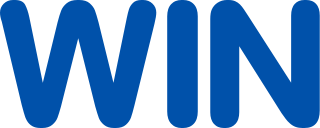
The Nine Network is a major Australian commercial free-to-air television network, that is a division of Nine Entertainment Co. with headquarters in Willoughby, a suburb located on the North Shore of Sydney, Australia. The Nine Network is one of three main free-to-air commercial networks in Australia.

WIN Television is an Australian television network owned by WIN Corporation that is based in Wollongong, New South Wales. WIN commenced transmissions on 18 March 1962 as a single Wollongong-only station, and has since expanded to 24 owned-and-operated stations with transmissions covering a larger geographical area of Australia than any other television network except for Australia Plus which broadcasts to 44 countries. In most areas it is a primary affiliate of Network 10.
TDT is a digital television station in Tasmania, Australia. It is jointly owned by WIN Corporation and Southern Cross Austereo, operating as Tasmanian Digital Television.
TVT is Tasmania's first television station, delivering its first official broadcast on 23 May 1960. The callsign stands for "TeleVision Tasmania". Unlike the commercial stations in Brisbane, Sydney, Melbourne, Adelaide, and later Perth, TVT held a monopoly in the Hobart market for many years.
TNT is a television station based in Launceston, Tasmania, Australia, owned by Southern Cross Austereo. Originally broadcasting only to Launceston and Northern Tasmania, it has broadcast to the whole of Tasmania since aggregation of the Tasmanian television market in 1994.

TND is a television station in Darwin, Northern Territory. The station, launched in 1998 as Seven Darwin and broadcasting to the greater Darwin region, serves around 100,000 people and is owned by Southern Cross Austereo. Its main competitor is Darwin's highest rating broadcaster, the Nine Network station, Nine Darwin.
Nine Regional is an Australian television network owned by Southern Cross Austereo that is broadcast in Queensland, New South Wales, the Australian Capital Territory, Victoria and South Australia. The network is the primary affiliate of the Nine Network in most regional areas.

Southern Cross Austereo (SCA) is an Australian group of companies formed in July 2011 by the merger of Southern Cross Media Group and Austereo Group. The Group's parent company, Southern Cross Media Group Limited, is listed on the Australian Stock Exchange.

Southern Cross Media Group is one of Australia's major media companies. On 3 July 2007 Southern Cross Broadcasting recommended Macquarie Media Group's offer of A$1.35 billion, for a takeover of the corporation. Under the deal, Macquarie Media Group would then onsell the metropolitan radio stations to Fairfax Media. On 5 November 2007, the company officially acquired Southern Cross Broadcasting's assets. On 17 December 2009 shareholders approved a restructuring plan. The company was then renamed from Macquarie Media Group to its current name on 17 December 2009.
This timeline of Australian television lists important station launches, programs, major television events, and technological advancements that have significantly changed the forms of broadcasting available to viewers of television in Australia. The history of television in Australia can be traced back to an announcement from the Menzies' government concerning plans for television services in Sydney and Melbourne.

7HD is an Australian television channel, owned by Seven West Media, originally launched on 15 October 2007 featuring unique breakaway programming from 10 December 2007 to 4 October 2009 and a HD simulcast of Seven until 25 September 2010. The channel is available to high definition digital television viewers in metropolitan areas through a number of owned-and-operated stations. On 25 September 2010, 7HD was replaced by the new channel 7mate.
9HD is an Australian television channel, owned by Nine Entertainment Co., originally launched on 17 March 2008 featuring unique "breakaway" programming until 2009 and a HD simulcast of the Nine Network from 2009-2010 and again since 26 November 2015. The channel is available on high definition digital television viewers in metropolitan and regional areas through a number of owned-and-operated and affiliate stations. Originally 9HD only simulcast blocks of programming from the Nine Network, and in 2008 it added time-shifted news, movies, drama and entertainment programs. Following the launch of 9Go! in August 2009, 9HD reverted to a HD simulcast of the Nine Network. The channel was replaced completely in 2010 and the space occupied by the newly launched multichannel 9Gem. Following the government's decision to remove the SD Primary Channel limitations, the channel returned as a HD simulcast on channel 90 on 26 November 2015.
STV is an Australian television station licensed to and serving the regions surrounding Mildura, Victoria, owned and operated by the WIN Corporation and part of the WIN Television network. The station commenced transmissions on 27 November 1965.
SGS/SCN are Australian regional television stations serving the Spencer Gulf of South Australia and the Broken Hill area of New South Wales, owned by Southern Cross Austereo. The station is based in Port Pirie, South Australia with satellite offices in Broken Hill, Port Augusta, Whyalla and Port Lincoln, and studio and playout facilities based in Canberra.

9Gem is an Australian free-to-air digital television multichannel, launched by the Nine Network in September 2010. It is a General Entertainment and Movies channel, the phrase from which the original name "GEM" is derived.
9Life is an Australian free-to-air digital television multichannel owned by Nine Entertainment Co. The channel airs mostly foreign lifestyle and reality programs, with the channel having a licensing agreement with Discovery Inc. for the distribution of many formats.




















